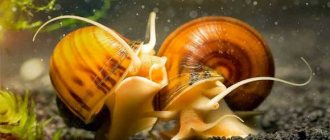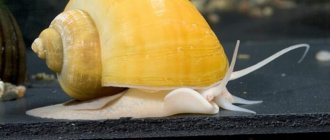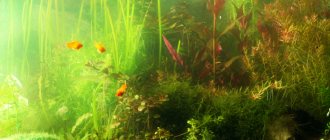Are snails needed in a home aquarium? Aquarists often differ in their opinions on this issue. Some argue that without such inhabitants a closed biological system will not be complete, while others argue that mollusks cause only harm. Aquarium snails can indeed pollute water, but only at increased planting densities. When placing snails in your artificial pond, remember that there should be at least 10 liters of water per individual. Now we will look at the most popular aquarium snails and find out what conditions are needed to keep them.
The role of snails in the aquarium
Whether snails are needed in an aquarium is impossible to answer unequivocally. If numbers are limited and controlled, then the benefit to the aquarium is significant. They will clean the tank and have a beneficial effect on the ecological system. Gastropods are considered useful creatures for the underwater kingdom, but are not at all essential. Therefore, each aquarist decides for himself whether to breed or urgently get rid of random guests.
Benefits of snails
The benefits of gastropods for an aquarium are as follows:
- careful, delicate removal of green algae, which quickly fill the aquarium, negatively affecting the biobalance of the home pond and appearance;
- eating food scraps, products of plant and animal origin that clog the aquarium, carrying the risk of developing an infection;
- the ability to maintain water in ideal condition in all respects, which is especially important during the spawning of aquatic inhabitants;
- possibility of being a kind of indicator of water purity - an alarming signal for an aquarist is the presence of snails on the surface of the water.
Snails are able to maintain water in ideal condition in all respects.
Shellfish do not eat fish eggs. Only rare species feed on eggs, and most likely only damaged ones. Not all species feed on healthy plants. In clean water, snails are practically invisible; they are either in the ground or hiding in the leaves of plants. But when oxygen becomes scarce, they rise to the surface. This indicator serves as a signal for the aquarist to urgently install ventilation.
And also, snail droppings produce protozoa, single-celled organisms, which are food for the fry. This is a huge benefit for spawning aquariums and fish farming.
Damage to snails
But not everything is as good as we would like in relation to gastropods. Many snails in an aquarium can cause harm:
- disturbance of the biological balance in water;
- creating an unsightly, untidy appearance in the aquarium;
- the ability to spread parasitic diseases that are dangerous not only for fish, but also for people;
- the possibility of contaminating water.
Of course, there are more benefits from shellfish than harm. But in order for them to demonstrate useful qualities, their numbers should be strictly regulated. Also, the aquarist should know what a particular species is, for which it is necessary to study the features of development, nutrition, and maintenance.
For snails to be useful, their numbers must be strictly regulated.
Otocinclus
Otocinclus catfish do an excellent job of removing grass deposits on the walls and decorations of the aquarium. They grow 3–6 cm long. In captivity they live 3–6 years. The differences between the species are only in size and color options. General characteristics:
- On the side there is a continuous or interrupted wide line of dark shades.
- A large dark spot on the caudal fin closer to the body.
- Pack behavior.
Pros of content:
- Undemanding to living conditions.
- Omnivorous.
- Non-aggressive behavior.
- Small size.
- They quickly eat unicellular algae.
Popular aquarium species of otocinclus:
- Ordinary.
- Mottled.
- Maria.
- Macrurus.
How to control the number of snails in an aquarium
The most important rule when controlling numbers is eliminating excess food. These creatures love to eat fish food, so there shouldn’t be too much of it. Aquarium pets should be fed in portions, and they should eat all the food within a few minutes. If access to a food source is excluded, and the water does not contain a large amount of alkali, which snails love, then reducing their population will not be difficult.
You can reduce the amount of natural food by:
- effective water filtration;
- frequent water changes;
- regular cleaning of the tank and soil;
- the presence of predators - some species of fish.
As the number of snails increases, they can be caught manually or using a bait trap. For example, you can change the water in a tank by transplanting fish and the required number of shellfish into another container. Or place a plastic bottle with fruit slices at the bottom of the aquarium. Curious omnivorous inhabitants of the aquatic space will definitely gather in a place where they can be easily removed.
You can prevent the appearance of gastropods if you disinfect purchased plants before planting them and sterilize the soil. It is also necessary to disinfect all decorative elements placed in the aquarium. Salt, potassium permanganate, and alum will help in this matter. There are also special preparations, but they contain copper, which negatively affects the health of the flora and fauna of a home pond.
Under no circumstances should you pour water from someone else’s tank into your own along with the purchased fish.
There should not be many snails in the aquarium - for a small tank (about 50 liters) three individuals will be enough. A large one (more than 100 liters) can accommodate 10 pieces.
For a small tank (about 50 liters) three individuals will be enough
Pterygoplichts or brocade catfish
Pterygoplichthus belongs to the genus of loricariid catfish. A beautiful fish of a dark, brown color, it destroys grassy plaque and algae in large quantities. It is not suitable for every aquarist, as it grows up to 50 cm. The body is oblong, widens towards the head, the upper part is covered with horny plates.
Distinctive features:
- The nostrils project upward.
- High dorsal fin.
- On the top of the head there is a bone growth in the form of a ridge.
2 brocade catfish can keep containers of 1–2 cubic meters clean. Lifespan in captivity is 8–15 years. Reproduction in aquariums is not possible. Behavior is moderately aggressive.
Keeping and caring for aquarium snails
It is possible to keep snails together with fish, but you need to take into account some features:
- multiply quickly, which leads to acute oxygen deficiency;
- when there is a shortage of food, the mollusks begin to feed on plants - it will take little time to empty the aquarium;
- waste products accumulate on the water surface, causing the water to become cloudy and bad for other inhabitants;
- a dead snail poses a danger to the inhabitants of the aquarium.
Shellfish should be purchased in specialized stores, otherwise parasites that spread infectious diseases can easily be introduced into the aquarium. Keep in a container with a lid, as inquisitive creatures will definitely want to explore the space adjacent to the water.
Shells provide protection from predators. The older the individual, the denser the shell. In young specimens it is fragile and delicate. But its construction requires minerals and calcium. Gastropods absorb these substances from water, which must be taken into account when keeping them with fish and plants; they can also be contained in aquarium shells.
Shells provide protection from predators
The food of mollusks consists of the remains of fish food, algae, and growths on glass. If necessary, they are fed with cucumbers, lettuce leaves, carrots, and cabbage.
Under no circumstances should you bring shellfish from natural bodies of water for breeding in an aquarium. They are carriers of infections and worms.
Ancistrus
The common ancistrus catfish perfectly cleans the surface of the aquarium from green deposits. The drop-shaped body is covered with keratinized plates. On the front part of the body there are bone growths in the form of horns. The structure of the mouth includes hard plates, which are natural scrapers. Various colors are possible - yellow, olive, gray, white.
The fish grow up to 10 cm. They live in aquariums for 5–8 years. The character is peaceful, conflicts are possible only between representatives of the same species. Ancistrus feed only on plants. Maintenance is not difficult. They reproduce independently in aquariums.
The most popular types of aquarium snails
Some species of snails require specific water temperatures and pH levels to be maintained. Beginning aquarists are better off choosing unpretentious varieties of mollusks that can easily withstand sudden temperature fluctuations and do not require special conditions. When keeping it, you need to periodically update the water, supply it with food and add minerals, the lack of which will negatively affect the health of the snails.
Fizy
Small, unpretentious physes are distinguished by the characteristic appearance of the shell, which twists to the left. They are very sneaky due to their small size, so they can easily get into any holes. They are omnivores, feeding on any plant, even tough ones. They multiply quickly. Physes are rarely used as aquarium orderlies and only under conditions of strict population control.
Physes multiply quickly
Melania
Unpretentious melania snails with a cone-shaped shell. They perfectly clean the soil, improving its air exchange. They reproduce quickly, and it is difficult to control the reproduction process. You may not even notice how the bottom of the aquarium will be covered with them for a short time.
Melania are excellent indicators of lack of oxygen in water.
Unpretentious snails with a cone-shaped shell
Tylomelania
Unusual, incredibly spectacular tilomelania can decorate a freshwater aquarium with their appearance. Their shell is long, pointed, bright yellow and orange. They grow large, and some varieties of this type of snail are distinguished by their aggressive nature. In their environment, they are able to tolerate only their relatives.
Spectacular tilomelania can decorate an aquarium with their appearance
Reels
One of the most undemanding species in terms of living conditions. However, a water filter is required for them, since the coils waste a lot of oxygen during their life. They are distinguished by their small size and spiral-twisted shell. Aquarium coils eat leftover fish food, rotting parts of plants and bacterial film on them. These are true orderlies of the water space.
One of the most undemanding species in terms of living conditions
It is interesting to watch these mollusks as they swim upside down on the surface of the water.
Ampularia
The most common mollusk in home aquariums. It has a yellow rounded shell. It is a heterosexual individual, so several representatives will be required to breed it. For some fish - bettas, cichlids - they are a tasty morsel. They themselves feed with equal appetite on algae and the sprouts of higher plants.
The most common mollusk in home aquariums
Marisa
Maryse is a large mollusk, the shell of which can reach a diameter of up to 6 cm. Its shape is similar to the shell of a coil snail. Females differ from males in color.
It’s bad that breeding them is quite difficult, since marises are extremely demanding on water quality. It is impossible to keep them in a tank with plants - they will simply eat them.
Maryse are extremely demanding on water quality
Omnivorous, voracious snails with an impressive appearance can be good orderlies for fish aquariums.
Neritines
The most favorite among aquarists are snails, which amaze with the varied colors of their shells. They feed on algal formations and reproduce only in salt water. They are completely indifferent to higher plants. Neritines are considered the most useful snails, which are actively kept by experienced aquarists.
Neritines are considered the most useful snails
Helena
The predatory snail is attractive in appearance, small in size, and its coloring is similar to a wasp. It is indispensable when there are a large number of mollusks in the tank, since in a short time it is able to completely clear it of their relatives. Helena is not at all interested in plants - she is ready to eat only shellfish. To breed them, it is enough to acquire four individuals of different sexes.
Predatory snail – attractive in appearance, small in size
Pagodas
Horned snails, capable of growing up to 6 cm. They prefer to feed on algae - especially black beard, which can quickly fill an aquarium. However, it is demanding of high concentrations of oxygen in water and cannot tolerate its deficiency. When organizing ventilation, he will play the role of a good aquarium orderly.
Horned snails that can grow up to 6 cm
River viviparus
Large mollusks, reaching a diameter of 5 cm, live at the bottom, in the very soil of the tank. They feed on leftover fish food and fallen leaves. Never touch the laid eggs. They play the role of good aquarium orderlies, actively cleaning the water space from decaying flora residues that can cause the development of infections.
Play the role of good aquarium orderlies
Melania
Is viviparous. The length of the mollusk shell is 3.5 cm. Its shape is a narrow cone, and its color ranges from light yellow-green to dark gray with clear purple strokes. The body is silver or lilac. The snail breathes through the gills, and a significant amount of oxygen is vital for it.
Melania soil cleaners. They mix the substrate, which improves gas exchange in the container and prevents the process of decay of organic matter trapped in the deep layer. Mollusks reproduce quickly, and to prevent unwanted population growth, excess mollusks are caught or added to the pond. Melania will only benefit a small number of individuals.
Snails to Avoid
Most aquarium snails are not harmful. On the contrary, each species is a good orderly for the water space. But, there are parasitic mollusks that spread infections, devour plants, and do more harm than good. An aquarium with such snails will take the owner a lot of time to care for and prevent reproduction. These are mollusks such as pond snail, meadow, and pearl barley.
Disputes between aquarists also arise due to melania, which actively “moves” the soil. This is good on the one hand, but on the other hand it negatively affects the appearance of the tank. In addition, it is very difficult to keep track of the rapid proliferation of melania.
Sevellia lined
Sevellia belongs to the Balitoridae family, the genus is flat-finned. A very interesting fish in shape, vaguely reminiscent of stingrays in appearance. The body is flattened, the caudal fin is turned parallel to the bottom surface.
Adults reach 5–6.5 cm. They live in captivity for 4–6 years. The character is absolutely not aggressive. Sevellias are demanding on the purity of water; their maintenance requires enhanced filtration and oxygen saturation. One individual requires a tank volume of 60-70 liters. Omnivorous. Higher plants are not eaten. Reproduction does not require special conditions from the owner.
How long do snails live in a home aquarium?
Snails live on average 2-3 years. In natural conditions they can live for 5 years. But in a home aquarium, the average lifespan of gastropods is no more than 2 years, subject to optimal maintenance conditions and the exclusion of predators from the reservoir. The lifespan of snails is affected by:
- water hardness - the higher it is, the better;
- water acidity – ideally from 7.0 to 8.0;
- The water temperature is warm, from 22 to 27 degrees, the mollusks feel better and do not hibernate.
If mollusks were bred specifically for reproduction, then it is quite advisable to provide them with adequate living conditions.
Snails live on average 2-3 years; in natural conditions they can live for 5 years
Loricaria
Family: Loricariid catfish. A distinctive feature is the head growths in the form of tree roots. The habits and features of keeping are similar to Pterygoplichthus and Ancistrus. Size 20–25 cm. Life expectancy in captivity 7–11 years. Based on their feeding method, they are classified as phytophages (vegetarians). Aquarium volume - from 110 liters.
There are more than 30 species of loricariid catfish. The most popular:
- Ordinary.
- Peruvian.
- Royal.
How to combat snail damage to plants
Snails eat higher plants out of hunger. Therefore, when keeping them in a home aquarium, it is necessary to provide them with feeding. If the fish do not have enough food in the form of uneaten food, then you can add scalded cabbage leaves, lettuce, finely chopped fruits and boiled vegetables to the shellfish diet. To eliminate the risk of snails eating plants, you can only keep certain species that are indifferent to flora.
It is up to every aquarist to house snails with other aquatic inhabitants or not. They can start there on their own. There is only one thing left to do - control the numbers and ensure optimal conditions of detention, which is not at all difficult. Watching their lives is incredibly exciting and funny. With just their appearance, snails lift your spirits, bringing a bit of positivity into a person’s everyday life.
And there are snails living in your aquarium. Were these gastropods specially bred or did they appear by chance? What type? Share your stories in the comments.
Panak or king catfish
The king catfish belongs to the loricariid family. The body is grayish-brown, covered with longitudinal stripes of dark colors. Grows up to 35 cm. In captivity, lives 9–16 years. Content difficulty is easy. Omnivorous. The character is moderately aggressive, especially towards related species. For the habitat of 1 individual, a tank of 180–200 liters is required.
There are 5 known varieties of royal catfish, differing mainly in body colors, shades, and direction of stripes:
- Tapajos - golden-linear.
- Tocantins - lines are located at an angle of 40-50 degrees from the head to the fins.
- Watermelon – red eyes, black lines.
- Xingu - pink and green lines.
- Olive – olive body, black lines.
Chaetostoma
Catfish belong to the chainmail family, genus Chaetostoma. 48 species are known. In the aquarium hobby, 2 types of cleaner fish are most widespread:
- Formosa, or striped bulldog. The difference is a diamond-shaped pattern, reminiscent of chain mail. Due to the flat end of the head, it received the nickname “bulldog”. Length 7–10 cm. Lifespan 4–7 years. Mixed food. Non-aggressive. The conditions of detention are similar to those of Chaetostoma milesi. Aquarium volume 80 liters minimum.
- Milesi - spotted chaetostoma. The main difference is the dark spotted color. Size 10–15 cm. Lives 6–8 years. Diet type: omnivorous. The character is peaceful. Necessary conditions of detention are saturation of water with oxygen and active filtration. Tank volume from 100 l.











